Understanding Wetlands Stratigraphy: Geophysics and Soil Parameters for Investigating Ancient Basin Development at Lake Duvensee
Abstract
1. Introduction
- To identify and continuously map the main stratigraphic units that fill the ancient Lake Duvensee to facilitate an understanding of the basin evolution. For this purpose, we combined sampling by drilling with ground-penetrating radar (GPR), electric resistivity tomography (ERT), and seismic sounding with shear waves (SH-waves seismic).
- To evaluate the suitability of GPR, ERT and SH-wave seismic to detect peat properties, paying attention to the identification of different gyttja layers.
- To determine the conditions under which peat and gyttja layers can be identified and distinguished in terms of geophysical parameters, particularly resistivity, shear wave velocity and dielectric permittivity.
2. Area of Investigation and Landscape Development
3. Methodology
3.1. Ground-Penetrating Radar (GPR)
3.1.1. GPR Surface Profiling
3.1.2. GPR Downhole Profiling Using Guided Waves
3.2. Geoelectric Profiling
3.2.1. Electrical Resistivity Tomography (ERT)
3.2.2. Vertical Electric Profiling Using Direct-Push
3.2.3. Electric Resistivity Measurements on Drill Cores
3.3. Seismic Sounding with Shear (SH) Waves
3.3.1. Motivation of Applying SH-Waves in Geoarchaeology
3.3.2. Seismic Refraction Tomography
3.3.3. Seismic Reflection Imaging
3.4. Acquisition of Stratigraphic Data by Drilling and Laboratory Analyses
- Water content and bulk density of the sediment samples were determined gravimetrically on small volumetric samples (ca. 2 cm3) after drying the sediment at 105 °C. The sediment of the remainder of the cores was air dried (35 °C), carefully disintegrated with mortar and pestle and sieved through a 2 mm mesh sieve before additional analysis.
- Grain size distribution analysis (<2 mm) was carried out for the sediment of the cores except of the peat layers. After the removal of soil organic matter (H2O2, 70 °C) and carbonates (acetic acid buffer, 70 °C, pH 4.8), the sand fractions of the sediment were separated by sieving through meshes of 630, 200, and 63 µm. The silt fractions (2–6.3, 6.3–20, 20–63 µm) and the clay (<2 µm) were separated by sedimentation in Atterberg cylinders.
- The magnetic susceptibility was measured on 10 mL samples (<2 mm fraction) using a Bartington MS2B susceptibility meter (resolution 2 × 10−6 SI, measuring range 1–9999 × 10−5 SI, systematic error 10%). Measurements were carried out at a low (0.465 kHz) frequency. A 1% Fe3O4 (magnetite) was measured regularly to check for drift and calibrate the results. Mass-specific susceptibilities were calculated [68].
- Loss on Ignition (LOI) values were measured as estimates of the organic matter and carbonate contents of the sediments [69]. After drying the samples at 105 °C overnight, the weight loss of the samples was determined after heating times of 2 h at 550 and 940 °C each.
- Total elemental contents were mesasured on selected samples using a NITON XL3t 900 ped-xrf analyser following the instructions of [70].
- Electrical conductivity of the pore water was determined on the water that sublimated during freeze drying of core samples. Samples were dried separately, and, after the thawing of the ice that formed on the condensator of the freeze dryer, the electrical conductivity of the pore water was measured using a conductivity meter of FA. WTW in µS/cm.
4. Results
4.1. ElectricalResistivity and Sediment Properties
4.2. Ground Penetrating Radar
4.2.1. Stratigraphy from GPR Reflection Profiling
- Interface1 represents the transition between the coarse organic sediments (peat and coarse detritus gyttja) at the surface and the underlying fine organic sediments (i.e., fine detritus gyttja, calcareous gyttja);
- Interface2 describes the transition between fine organic sediments and underlying clayish-loamy deposits in the bottom of the previous lake;
- Interface3 marks the transition between the clayish-loamy layer and the basal sand deposits.
- (1)
- Pedogenized peat (vermulmter Torf) visible in the first 10 cm (P1 in Figure 4c,d);
- (2)
- Grounded peat (vererdeter Torf) carrying a crumb structure and locally roots, usually concentrated between 10 and 40 cm (P2 in Figure 4c,d);
- (3)
- Strongly decomposed peat, below 40 cm, (stark zersetzter Torf) with a fine grain structure and wood remains in it (P3 in Figure 4c,d).
4.2.2. Guided Radar Waves
4.3. Electrical Resistivity Tomography
4.4. Shear Wave Seismics
4.5. Comparison of Sedimentological and Geophysical Soil Parameters
4.6. Peatland Development
5. Discussion
5.1. Stratigraphy of Bogs
5.1.1. GPR Survey
5.1.2. ERT Survey
5.1.3. SH-Wave Survey
5.2. Degradation and Compaction of the Peat
5.3. Methodological Questions
6. Conclusions
- GPR can identify the main transition between sediments that differ in grain size, and the boundary between the uppermost poorly decomposed peat (“acrotelm”) and underlying well-decomposed peat (‘’catotelm’’). Moreover, the distinction between different gyttjas is locally visible with small scattered reflection but without an orientation.
- ERT is capable of distinguishing between sediments with different grain sizes but is not able to distinguish between different fine-grained lake sediments; therefore, the different gyttja types are not detected. However, depending on site conditions, ERT is able to indicate regions of gradually changing properties, such as the solutes in the pore fluid. Perhaps the high ionic concentration of the permanent groundwater body present in the lower part of the ancient lake basin is masking differences in sediment properties. The small-scale variations, due to different degrees decomposition and organic remains, in the peat layer were visible as resistivity changes.
- SH-wave seismics enables exploring the deepest stratigraphy (up to ~19m depth), in which the major interfaces can be found from the S-wave velocity distribution as provided by refraction tomography. The method can distinguish between sediments with different grain sizes. The vertical resolution is ~0.2–0.7 m through SH-wave reflection imaging allowing for the detection of the main interfaces as GPR. SH-wave velocity values of the organic sediments are in the range of 40 to 80m/s, whereas the glacial sands have velocities of 100 to 250 m/s. This means that sediments presenting a weaker matrix can be very easily defined and mapped.
- Strongly degraded peat presents physical parameters similar to detritus gyttja.
- Fine detritus gyttja can be distinguished from the coarse detritus gyttja.
- The calcareous gyttja can be detected using a combination ofphysical parameters and soil analysis.
- Resistivity is well correlated with water content and organic matter for distinguishing between different peat degrees of decomposition and different gyttjas (calcareous/fine).
- ERT and GPR guided waves allowed for the distinction between different degrees of peat decomposition, but the depth of investigation was not enough to statistically separate the different gyttjas.
- Sesmics allows for an estimation of sediment density.
Supplementary Materials
Author Contributions
Funding
Acknowledgments
Conflicts of Interest
Appendix A
| Property | Material | Value | References |
|---|---|---|---|
| Total porosity | peat | ~70 to 95% | [8,71,94,95] |
| gyttja | ~0.90 to 0.95% | ||
| Compression | peat | ~10 to 50% | [10,95] |
| detr. calc. gyttja | ~5-35% | ||
| Pore diameter | peat | ~0.1–5 mm | [9,96] |
| Organic matter | gyttja | ~40–80% ~30–95% | [27,97] |
| Water content | peat | ~85–95% | [18,27] |
| org. gyttja | ~85–88% | ||
| min. gyttja | ~72–75% | ||
| Bulk density | peat | 0.08–0.17 g/cm3 | [18,41] |
| org. gyttja | 0.13–0.22 g/cm3 | ||
| min. gyttja | 0.27g/cm3 | ||
| Dielectric permittivity (GPR velocity) | Air | 1 (0.30 m/ns) | [33,34] [25] [76] [32] |
| Fresh water | 80 (0.033 m/ns) | ||
| Clay (dry) | 2.5 (0.10 m/ns) | ||
| Clay (wet) | 5–40 (0.05–0.06 m/ns) | ||
| gyttja | 23–27(0.06–0.07 m/ns) | ||
| Silt | 5–30 (0.05–0.07 m/ns) | ||
| Sandy clay | 16.87 (0.073 m/ns) | ||
| Sand (dry) | 2.55–7.5 (0.1–0.2 m/ns) | ||
| Sand (wet) | 20–31.6 (0.05–0.07 m/ns) | ||
| Fen peat | 40.69–34.56 (0.047–0.051 m/ns) | ||
| Wood peat | 56.18 (0.040 m/ns) | ||
| Peat | 40.7–73.5 (0.035–0.0479 m/ns) | ||
| Freshwater peat | 57–80 (0.03–0.06 m/ns) | ||
| Conductivity/Resistivity | Sand (dry) | 0.01 mS/m | [8,33] |
| Silts | 1–100 mS/m | ||
| Clays | 2–1000 mS/m | ||
| undecomp. peat | 35–44 Ωm | ||
| decomposed peat | 20–25 Ωm |
Appendix B
- Determining a reference velocity model.
- 2.
- Determination of smoothing weight.
- 3.
- Determining the final velocity model and its dependence on the starting model
References
- Van de Noort, R.; O’Sullivan, A. Rethinking Wetland Archaeology; Gerald Duckworth and Co. Ltd.: London, UK, 2006. [Google Scholar]
- Lillie, M.; Ellis, S. Wetland Archaeology and Environments: Regional Issues, Global Perspectives; Oxbow Books: Oxford, UK, 2007. [Google Scholar]
- Menotti, F. Wetland Archaeology and Beyond: Theory and Practice; OxfordUniversity Press: Oxford, UK, 2012. [Google Scholar]
- Brown, A.G. Alluvial Geoarchaeology-Floodplain Archaeology and Environmental Change; Cambridge Manuals in Archaeology; Cambridge University Press: Cambridge, UK, 1997. [Google Scholar]
- Utsi, E. Ground-penetrating radar time-slices from North Ballachulish Moss. Archaeol. Prospect 2004, 11, 65–75. [Google Scholar] [CrossRef]
- Doran, G.H. Excavating wet sites. In The Oxford Handbook of Wetland Archaeology; Menotti, F., O’Sullivan, A., Eds.; Oxford University Press: Oxford, UK, 2013; pp. 483–494. [Google Scholar]
- Soil Classification Working Group. Canadian System of soil Classification; Agric. And Agri-Food can. Publ: Ottawa, ON, Canada, 1998. [Google Scholar]
- Boelter, D.H. Important physical properties of peat materials. In Proceedings of the 3rd International Peat Congress, Quebec, QC, Canada, 18–23 August 1968; pp. 150–154. [Google Scholar]
- Rezanezhad, F.; Quinton, W.L.; Price, J.S.; Elrick, D.; Elliot, T.R.; Heck, R.J. Examining the effect of pore size distribution and shape on flowthrough unsaturated peat using 3-D computed tomography. Hydrol. Earth Syst. Sci. 2009, 13, 1993–2002. [Google Scholar] [CrossRef]
- Rezanezhad, F.; Price, J.S.; Quinton, W.L.; Lennartz, B. Structure of peat soils and implications for water storage, flow and solute transport: A review update for geochemists. Chem. Geol. 2016, 429, 75–84. [Google Scholar] [CrossRef]
- Kettridge, N.; Comas, X.; Baird, A.; Slater, L.; Strack, M.; Thompson, D.; Jol, H.; Binley, A. Ecohydrologically important subsurface structures in peatlands revealed by ground-penetrating radar and complex conductivity surveys. J. Geophys. Res. 2008, 113, 1–15. [Google Scholar] [CrossRef]
- Price, J.S.; Cagampan, J.; Kellner, E. Assessment of peat compressibility: Is there an easy way? Hydrol. Process. 2005, 19, 3469–3475. [Google Scholar] [CrossRef]
- Kennedy, G.W.; Price, J.S. A conceptual model of volume-change controls on the hydrology of cutover peats. J. Hydrol. 2005, 302, 13–27. [Google Scholar] [CrossRef]
- Heller, C.; Zeitz, J. Stability of soil organic matter in two northeastern German fen soils: The influence of site and soil development. J. Soils Sediments 2012, 12, 1231–1240. [Google Scholar] [CrossRef]
- Von Post, H. Studier öfver nutidens koprogena jordbildningar; gyttja, dy och mylla (Studies about soil formation of coprogenic origin; gyttja, dy, turf/sod and silt/load). Kongliga Sven. Vetensk. Akad. Handl. 1862, 4, 1–59. (In Swedish) [Google Scholar]
- Comas, X.; Slater, L.; Reeve, A. Geophysical evidence for peat basin morphology and lithologic controls on vegetation observed in a northern peatland. J. Hydrol. 2004, 295, 173–184. [Google Scholar] [CrossRef]
- Stegmann, H.; Succow, M.; Zeitz, J. Muddearten (Types of Gyttja). In Landschaftsökologische Moorkunde; Succow, M., Joosten, H., Eds.; Schweizerbart: Stuttgart, Germany, 2001. [Google Scholar]
- Walter, J.; Hamann, G.; Klingenfuss, C.; Zeitz, J. Stratigraphy and soil properties of fens: Geophysical case studies from northeastern Germany. Catena 2016, 142, 112–125. [Google Scholar] [CrossRef]
- Becker, A.; Bucher, F.; Davenport, C.; Flisch, A. Geotechnical characteristics of post-glacial organic sediments in Lake Bergsee, southern Black Forest, Germany. Eng. Geol. 2004, 74, 91–102. [Google Scholar] [CrossRef]
- Comas, X.; Slater, L.; Reeve, A. Stratigraphic controls on pool formation in a domed bog inferred from ground penetrating radar (GPR). J. Hydrol. 2005, 315, 40–51. [Google Scholar] [CrossRef]
- Hadler, H.; Vött, A.; Newig, J.; Emde, K.; Finkler, C.; Fischer, P.; Willershäuser, T. Geoarchaeological evidence of marshland destruction in the area of Rungholt, present-day Wadden Sea around Hallig Südfall (North Frisia, Germany), by the Grote Mandrenke in 1362 AD. Quat. Int. 2018, 473, 37–54. [Google Scholar] [CrossRef]
- Zielhofer, C.; Rabbel, W.; Wunderlich, T.; Vött, A.; Berg, S. Integrated geophysical and (geo) archaeological explorations in wetlands. Quat. Int. 2018, 473, 1–2. [Google Scholar] [CrossRef]
- Corradini, E.; Eriksen, B.V.; Fischer Mortensen, M.; Krog Nielsen, M.; Thorwart, M.; Krüger, S.; Wilken, D.; Pickartz, N.; Panning, D.; Rabbel, W. Investigating lake sediments and peat deposits with geophysical methods—A case study from a kettle hole at the Late Palaeolithic site of Tyrsted, Denmark. Quat. Int. 2020. under review. [Google Scholar]
- Wunderlich, T.; Fischer, P.; Wilken, D.; Hadler, H.; Erkul, E.; Mecking, R.; Günther, T.; Heinzelmann, M.; Vött, A.; Rabbel, W. Constraining Electric resistivity Tomography by direct push electric conductivity logs and vibracores: An exemplary study of the fiume Morto silted riverbed (Ostia Antica, western Italy). Geophysics 2018, 83, 1–58. [Google Scholar] [CrossRef]
- Milton, C.J. Geophysics and geochemistry: An interdisciplinary approach to archaeology in wetland contexts. J. Archaeol. Sci. Rep. 2018, 18, 197–212. [Google Scholar] [CrossRef]
- Warner, B.G.; Nobes, D.C.; Theimer, B.D. An application of ground penetrating radar to peat stratigraphy of Ellice Swamp, southwestern Ontario. Can. J. Earth Sci. 1990, 27, 932–938. [Google Scholar] [CrossRef]
- Theimer, B.D.; Nobes, D.C.; Warner, B.G. A study of the geoelectrical properties of peatlands and their influence on ground-penetrating radar surveying. Geophys. Prospect. 1994, 42, 179–209. [Google Scholar] [CrossRef]
- Slater, L.; Reeve, A. Understanding peatland hydrology and stratigraphy using integrated electrical geophysics. Geophysics 2002, 67, 365–378. [Google Scholar] [CrossRef]
- Persico, R.; Soldovieri, F.; Utsi, E. Microwave tomography for processing of GPR data at Ballachulish. J. Geophys. Eng. 2010, 7, 164–177. [Google Scholar] [CrossRef]
- Ruffell, A.; McKinley, J. Forensic geomorphology. Geomorphology 2014, 206, 14–22. [Google Scholar] [CrossRef]
- Corradini, E.; Wilken, D.; Zanon, M.; Groß, D.; Lübke, H.; Panning, D.; Dörfler, W.; Rusch, K.; Mecking, R.; Erkul, E. Reconstructing the palaeoenvironment at the early Mesolithic site of Lake Duvensee: Ground-penetrating radar and geoarchaeology for 3D facies mapping. Holocene 2020, 30. [Google Scholar] [CrossRef]
- Lowry, C.S.; Fratta, D.; Abdreson, M.P. Ground penetrating radar and spring formation in a groundwater dominated peat wetland. J. Hydrol. 2009, 373, 68–79. [Google Scholar] [CrossRef]
- Davis, J.L.; Annan, A.P. Ground-penetrating radar for high-resolution mapping of soil and rock stratigraphy. Geophys. Prospect. 1989, 37, 531–551. [Google Scholar] [CrossRef]
- Conyers, L.B. Ground-Penetrating Radar for Archaeology; Altamira Press: Plymouth, MA, USA, 2004. [Google Scholar]
- Styles, P. Environmental Geophysics: Everything You Ever Wanted (Needed!) to Know but Were Afraid to Ask; EAGE: Amsterdam, The Netherlands, 2012. [Google Scholar]
- Comas, X.; Terry, N.; Slater, L.; Warren, M.; Kolka, R.; Kristiyono, A.; Sudiana, N.; Nurjaman, D.; Darusman, T. Imaging tropical peatlands in Indonesia using ground-penetrating radar (GPR) and electrical resistivity imaging (ERI): Implications for carbon stock estimates and peat soil characterization. Biogeosciences 2015, 12, 2995–3007. [Google Scholar] [CrossRef]
- Plado, J.; Sibul, I.; Mustasaar, M.; Jõeleht, A. Ground-penetrating radar study of the Rahivere peat bog, eastern Estonia. Est. J. Earth Sci. 2011, 60, 31–42. [Google Scholar] [CrossRef]
- Eggelsmann, R.; Heathwaite, A.L.; Grosse-Brauckmann, G.; Küster, E.; Naucke, W.; Schuch, M.; Schweickle, V. Physical processes and properties of mires. In Mires: Processes, Exploitation and Conservation; Göttlich, K., Heathwaite, A.L., Eds.; Wiley: New York, NY, USA, 1993. [Google Scholar]
- Meyer, J.H. Investigation of Holocene organic sediments: A geophysical approach. Int. Peat J. 1989, 3, 45–57. [Google Scholar]
- Wunderlich, T.; Petersen, H.; al Hagrey, S.A.; Rabbel, W. Pedophysical Models for Resistivity and Permittivity of Partially Water-Saturated Soils. Vadose Zone J. 2013, 12, 1–14. [Google Scholar] [CrossRef]
- Walter, J.; Lück, E.; Bauriegel, A.; Richter, C.; Zeitz, J. Multi-scale analysis of electrical conductivity of peatlands for the assessment of peat properties. Eur. J. Soil Sci. 2015, 66, 639–650. [Google Scholar] [CrossRef]
- Wunderlich, T.; Wilken, D.; Erkul, E.; Rabbel, W.; Vött, A.; Fischer, P.; Hadler, H.; Heinzelmann, M. The river harbour of Ostia Antica—Stratigraphy, extent and harbour infrastructure from combined geophysical measurements and drillings. Quat. Int. 2017, 473, 55–65. [Google Scholar] [CrossRef]
- Rabbel, W.; Stümpel, H.; Woelz, S. Archeological prospecting with magnetic and shearwave surveys at the ancient city of Miletos (western Turkey). Lead. Edge 2004, 23, 690–703. [Google Scholar] [CrossRef]
- Rabbel, W.; Wilken, D.; Wunderlich, T.; Bödecker, S.; Brückner, H.; Byock, J.; von Carnap-Bornheim, C.; Kalmring, S.; Karle, M.; Kennecke, H.; et al. Geophysikalische Prospektion von Hafensituationen—Möglichkeiten, Anwendungen und Forschungsbedarf. In Häfen im 1. Millennium A.D.—Bauliche Konzepte, Herrschaftliche und Religiöse EINFLÜSSE; Schmidts, T., Vučetić, M., Eds.; Romano-Germanic Central Museum Press (RGZM): Mainz, Germany, 2015; ISBN 978-3-79543-039-9. [Google Scholar]
- Wunderlich, T.; Wilken, D.; Erkul, E.; Rabbel, W.; Vött, A.; Fischer, P.; Hadler, H.; Ludwig, S.; Heinzelmann, M. The harbour(s) of ancient Ostia. Archaeological prospection with shear-wave seismics, geoelectrics, GPR and vibracorings. Special Theme: Archaeological Prospection. Archaeol. Pol. 2015, 53, 539–542. [Google Scholar]
- Obrocki, L.; Vött, A.; Wilken, D.; Fischer, P.; Willershäuser, T.; Koster, B.; Lang, F.; Papanikolaou, I.; Rabbel, W.; Reicherter, K. Tracing tsunami signatures of the AD 551 and AD 1303 tsunamis at the Gulf of Kyparissia (Peloponnese, Greece) using direct push in situ sensing techniques combined with geophysical studies. Sedimentology 2018, 67, 1274–1308. [Google Scholar] [CrossRef]
- Köhn, D.; Wilken, D.; De Nil, D.; Wunderlich, T.; Rabbel, W.; Werther, L.; Schmidt, J.; Zielhofer, C.; Linzen, S. Comparison of time-domain SH waveform inversion strategies based on sequential low and bandpass filtered data for improved resolution in near-surface prospecting. J. Appl. Geophys. 2018, 160, 69–83. [Google Scholar] [CrossRef]
- Schwardt, M.; Köhn, D.; Wunderlich, T.; Wilken, D.; Seeliger, M.; Schmidts, T.; Brückner, H.; Başaran, S.; Rabbel, W. Characterisation of silty to fine-sandy sediments with SH-waves: Full waveform inversion in comparison to other geophysical methods. Near Surf. Geophys. 2020, 18, 217–248. [Google Scholar] [CrossRef]
- Lamair, L.; Hubert-Ferrari, A.; Yamamoto, S.; Fujiwara, O.; Yokoyama, Y.; Garret, E.; De Batist, M.; Heyvaert, V.M.A.; Boes, E.; Nakamura, A.; et al. Use of high-resolution seismic reflection data for paleogeographical reconstruction of shallow Lake Yamanaka (Fuji Five Lakes, Japan). Palaeogeogr. Palaeoclimatol. Palaeoecol. 2019, 514, 233–250. [Google Scholar] [CrossRef]
- Groß, D.; Lübke, H.; Schmölcke, U.; Zanon, M. Early Mesolithic activities at ancient lake Duvensee, northern Germany. Holocene 2018, 29, 197–208. [Google Scholar] [CrossRef]
- Roessler, L. Erdgeschichte des Herzogtums Lauenburg; Ratzeburg: Albrechts, Germany, 1957. [Google Scholar]
- Averdieck, F.R. Palynological investigations in sediments of ancient lake Duvensee, Schleswig-Holstein (North Germany). Hydrobiologica 1986, 143, 407–410. [Google Scholar] [CrossRef]
- Bokelmann, K. Spade paddling on a Mesolithic lake—Remarks on Preboreal and Boreal sites from Duvensee (Northern Germany). In A Mind Set on Flint. Studies in Honour of Dick Stapert; Niekus, M.J.L.T., Barton, R.N.E., Street, M., Eds.; Groningen Archaeological Studies: Groningen, The Netherlands, 2012; pp. 369–380. [Google Scholar]
- Groß, D.; Piezonka, H.; Corradini, E.; Schmölcke, U.; Zanon, M.; Dörfler, W.; Dreibrodt, S.; Feeser, I.; Krüger, S.; Lübke, H.; et al. Adaptations and transformations of hunter-gatherers in forest environments: New archaeological and anthropological insights. Holocene 2019, 29, 1531–1544. [Google Scholar] [CrossRef]
- Wunderlich, T.; Rabbel, W. Absorption and frequency shift of GPR signals in sandy and silty soils: Empirical relations between quality factor Q, complex permittivity and clay and water contents. Near Surf. Geophys. 2013, 11, 117–127. [Google Scholar] [CrossRef]
- Igel, J.; Stadler, S.; Günther, T. High-resolution investigation of the capillary transition zone and its influence on GPR signatures. In Proceedings of the 16th International Conference of Ground Penetrating radar (GPR), Hong Kong, China, 13–16 June 2016. [Google Scholar]
- Loke, M.H. Tutorial: 2D and 3D Electrical Imaging Surveys 2016. Available online: www.geotomosoft.com (accessed on 13 August 2020).
- Günter, T.; Rücker, C. A general approach for introducing information into inversion and examples from dc resistivity inversion. Annu. Eur. Meet. Environ. Eng. Geophys. 2006. [Google Scholar] [CrossRef]
- Hansen, P.C.; O’Leary, D.P. The use of the L-curve in the regularization of discrete ill-posed problems. J. Sci. Comput. 1993, 14, 1487–1503. [Google Scholar] [CrossRef]
- Fischer, P.; Wunderlich, T.; Rabbel, W.; Vött, A.; Willershäuser, T.; Baika, K.; Rigakou, D.; Metallinou, G. Combined electrical resistivity tomography (ERT), direct-push electrical conductivity logging (DP-EC) and coring—A new methodological approach in geoarchaeological research. Archaeol. Prospect. 2016, 23, 213–288. [Google Scholar] [CrossRef]
- Harrington, G.A.; Hendry, M.J. Using Direct-Push EC Logging to delineate heterogeneity in a clay-rich aquitard. Ground Water Monit. Remediat. 2006, 26, 92–100. [Google Scholar] [CrossRef]
- Direct Image, Electric Conductivity (EC) Logging. Standard Operating Procedure, Kansas, 2008.
- Stümpel, H.; Kähler, S.; Meissner, R.; Milkereit, B. The use of seismic shear waves and compressional waves for lithological problems of shallow sediments. Geophys. Prospect. 1984, 32, 662–675. [Google Scholar] [CrossRef]
- Yilmaz, Ö. Seismic Data Analysis; Society of Exploration Geophysicists: Tulsa, OK, USA, 2001; Volume 1. [Google Scholar]
- Fujie, G.; Kasahara, J.; Murase, K.; Mochizuki, K.; Kaneda, Y. Interactive analysistools for the wide-angle seismic data 440 for crustal structure study (Technical Report). Explor. Geophys. 2008, 39, 26–33. [Google Scholar] [CrossRef]
- Korenaga, J.; Holbrook, W.S.; Kent, G.M.; Kelemen, P.B.; Detrick, R.S.; Larsen, H.-C.; Hopper, J.R.; Dahl-Jensen, T. Crustal structure of the Southeast Greenland margin from joint refraction and reflection seismic tomography. J. Geophys. Res. 2000, 105, 21591–21614. [Google Scholar] [CrossRef]
- Mingram, J.; Negendank, J.F.W.; Brauer, A.; Berger, D.; Hendrich, A.; Köhler, M.; Usinger, H. Long cores from small lakes—Recovering up to 100 m-long lake sediment sequences with a high-precision rod-operated piston corer (Usinger-corer). J. Paleolimnol. 2007, 37, 517–528. [Google Scholar] [CrossRef]
- Dearing, J. Environmental Magnetic Susceptibility: Using the Bartington MS2 System, 2nd ed.; Bartington Instruments Ltd.: Witney, UK, 1999. [Google Scholar]
- Dean, W.E. Determination of Carbonate and Organic Matter in Calcareous Sediments and Sedimentary Rocks by Loss on Ignition: Comparison with Other Methods. J. Sediment. Petrol. 1974, 44, 242–248. [Google Scholar]
- Dreibrodt, S.; Furholt, M.; Hofmann, R.; Hinz, M.; Cheben, I. P-ed-XRF-geochemical signatures of a 7300 year old Linear Band Pottery House ditch fill at Vráble-Ve’lké Lehemby, Slovakia—House inhabitation and post-depositional processes. Quat. Int. 2017, 438, 131–143. [Google Scholar] [CrossRef][Green Version]
- Boelter, D.H. Physical properties of peat as related to degree of decomposition. Soil Sci. Soc. Am. J. 1969, 33, 606–609. [Google Scholar] [CrossRef]
- Conyers, L.B. Ground-Penetrating Radar for Archaeology, 3rd ed.; Altamira Press: Lanham, MD, USA, 2013. [Google Scholar]
- Deutsche Bundesstiftung Umwelt. Steckbriefe Moorsubstrate; Hochschule für nachhaltige Entwicklung (FH): Eberswalde, Germany, 2011. [Google Scholar]
- Gomberg, J.; Waldron, B.; Schweig, E.; Hwang, H.; Webbers, A.; van Arsdale, R.; Tucker, K.; Williams, R.; Street, R.; Mayne, P.; et al. Lithology and shear-wave velocity in Memphis, Tennessee. Bull. Seismol. Soc. Am. 2003, 93, 986–997. [Google Scholar] [CrossRef][Green Version]
- Bokelmann, K. Duvensee, Wohnplatz 9: Ein präboreal-zeitlicher Lagerplatz in Schleswig-Holstein. Offa 1991, 48, 75–114. [Google Scholar]
- Neal, A. Ground-penetrating radar and its use in sedimentology: Principles, problems and progress. Earth Scie. Rev. 2004, 66, 261–330. [Google Scholar] [CrossRef]
- Curtis, J.O. Moisture effects on the dielectric properties of soils. IEEE Trans. Geosci. Remote Sens. 2001, 39, 125–128. [Google Scholar] [CrossRef]
- McNeill, J.D. Electrical Conductivity of Soils and Rocks; Geonics Limited: Mississauga, ON, Canada, 1980. [Google Scholar]
- Gustavsen, L.; Cannell, R.J.; Nau, E.; Tonning, C.; Trinks, I.; Kristiansen, M.; Poscetti, V. Archaeological prospection of a specialized cooking-pits at Lunde in Vestfold, Norway. Archaeol. Prospect. 2018, 25, 17–31. [Google Scholar] [CrossRef]
- Groß, R. Untersuchung zur Ausbreitung Elektromagnetischer Wellen in Wassergesättigt Medien und Kartierung von Mooren mit dem EMR-Verfahren (Investigation of the Dispersion of Electromagnetic Waves in Water-Saturated Media and Mapping of Peatlands with the EMR-Techniques). Ph.D. Thesis, University of Münster, Muenster, Germany, 1997. [Google Scholar]
- Anbazhagan, P.; Uday, A.; Moustafa, S.S.; Al-Arifi, N.S. Correlation of densities with shear wave velocities and SPT N values. J. Geophys. Eng. 2016, 13, 320–341. [Google Scholar] [CrossRef]
- Garia, S.; Pal, A.K.; Ravi, K.; Nair, A.M. A comprehensive analysis on the relationship between elastic wave velocities and petrophysical properties of sedimentary rocks based on laboratory measurements. J. Pet. Explor. Prod. Technol. 2019, 9, 1869–1881. [Google Scholar] [CrossRef]
- Price, J.S.; Schlotzhauer, S.M. Importance of shrinkage and compression in determining water storage changes in peat: The case of a mined peatland. Hydrol. Process. 1999, 13, 2591–2601. [Google Scholar] [CrossRef]
- Van Asselen, S.; Stouthamer, E.; Van Asch, T.W. Effects of peat compaction on delta evolution: A review on processes, responses, measuring and modeling. Earth Sci. Rev. 2009, 92, 35–51. [Google Scholar] [CrossRef]
- Van Asselen, S. The contribution of peat compaction to total basin subsidence: Implications for the provision of accommodation space in organic-rich deltas. Basin Res. 2011, 23, 239–255. [Google Scholar] [CrossRef]
- Frolking, S.; Roulet, N.T.; Moore, T.R.; Richard, P.J.H.; Lavoie, M.; Muller, S.D. Modeling northern peatland decomposition and peat accumulation. Ecosystems 2001, 4, 479–498. [Google Scholar] [CrossRef]
- Swanson, D.K.; Grigal, D.F. A simulation model of mire patterning. Oikos 1988, 53, 309–314. [Google Scholar] [CrossRef]
- Couwenberg, J.; Joosten, H. Self-organisation in raised bog patterning: The origin of microtope zonation and mesotope diversity. J. Ecol. 2005, 93, 1238–1248. [Google Scholar] [CrossRef]
- Mighall, T.M.; Dumayne-Peaty, L.; Cranstone, D. A record of atmospheric pollution and vegetation change as recorded in three peat bogs from the Northern Pennines Pb-Zn Orefield. Environ. Archaeol. 2004, 9, 13–38. [Google Scholar] [CrossRef]
- Dreibrodt, S.; Lomax, J.; Nelle, O.; Lubos, C.; Fischer, P.; Mitusov, A.; Reiss, S.; Radtke, U.; Grootes, P.M.; Bork, H.-R. Are mid Latitude slope deposits sensitive to climatic oscillations? Implications from an Early Holocene sequence of slope deposits and buried soils from Eastern Germany. Geomorphology 2010, 122, 351–369. [Google Scholar] [CrossRef]
- Comas, X.; Slater, L.; Reeve, A. Poolpatterning in a northern peatland: Geophysical evidence for the role of postglacial landforms. J. Hydrol. 2011, 399, 173–184. [Google Scholar] [CrossRef]
- Köhn, D.; Wilken, D.; Wunderlich, T.; DeNil, D.; Rabbel, W.; Werther, L.; Schmidt, J.; Zielhofer, C.; Linzen, S. Seismic SH full waveform inversion as new prospection method in archaeo-geophysics. In Proceedings of the 80th Conference and Exhibition, EAGE, Copenhagen, Denmark, 11–14 June 2018. [Google Scholar]
- Socco, L.; Foti, S.; Boiero, D. Surface-wave analysis for building near-surface velocity models—Established approaches and new perspectives. Geophysics 2010, 75, A83–A102. [Google Scholar] [CrossRef]
- Schwärzel, K.; Renger, M.; Sauerbrey, R.; Wessolek, G. Soil physical characteristics of peat soils. J. Plant Nutr. Soil Sci. 2002, 165, 479–486. [Google Scholar] [CrossRef]
- Malloy, S.; Pice, J.S. Consolidation of hyttja in a rewetted fen peatland: Potential implications for restoration. Mires Peat 2017, 19, 1–15. [Google Scholar]
- Quinton, W.L.; Gray, D.M.; Marsh, P. Subsurface drainage from hummock-covered hillslope in the Arctic tundra. J. Hydrol. 2000, 237, 113–125. [Google Scholar] [CrossRef]
- Constable, S.C.; Parker, R.L.; Constable, C.G. Occam’s inversion: A practical algorithm for generating smooth models from electromagnetic sounding data. Geophysics 1987, 52, 289–300. [Google Scholar] [CrossRef]
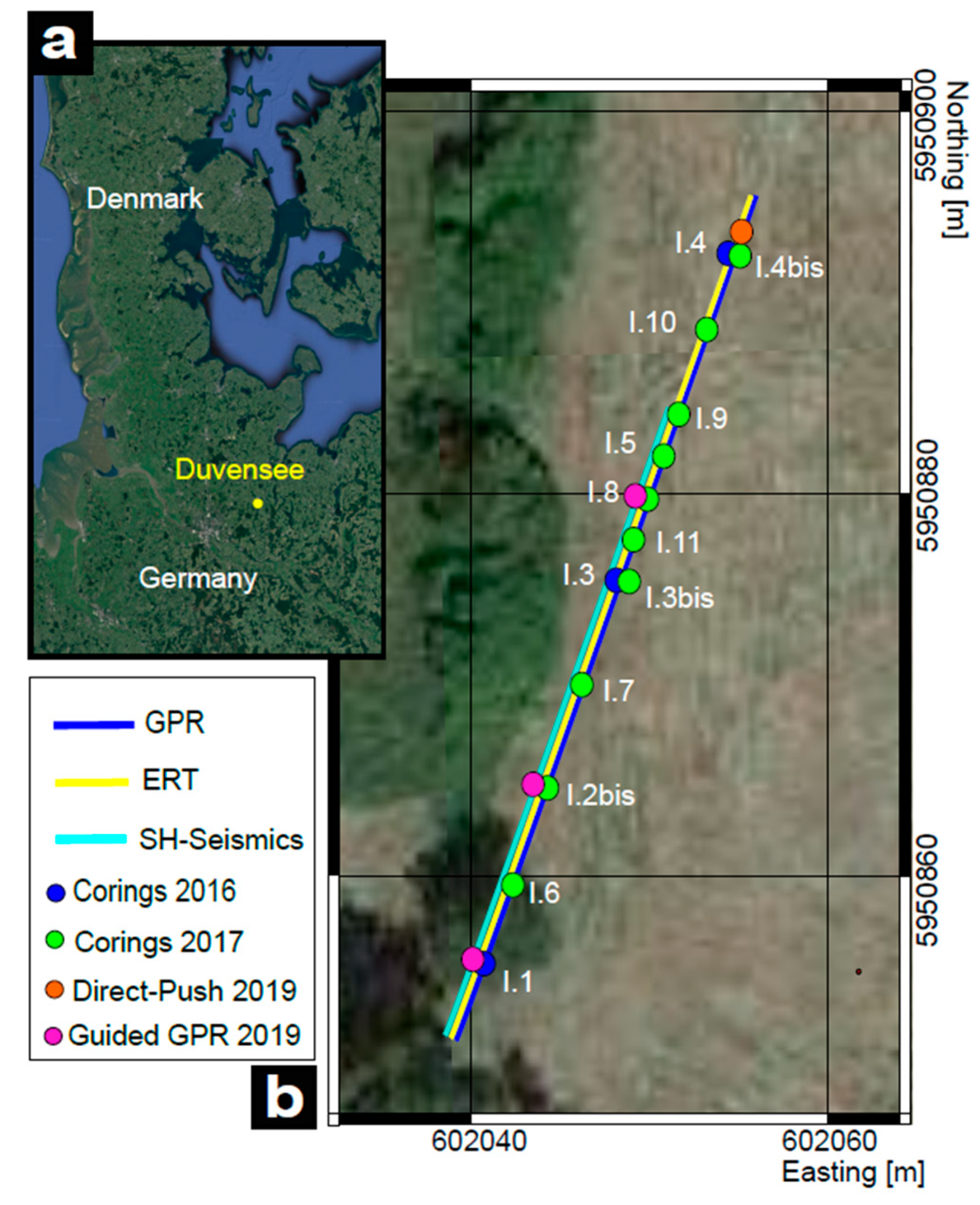
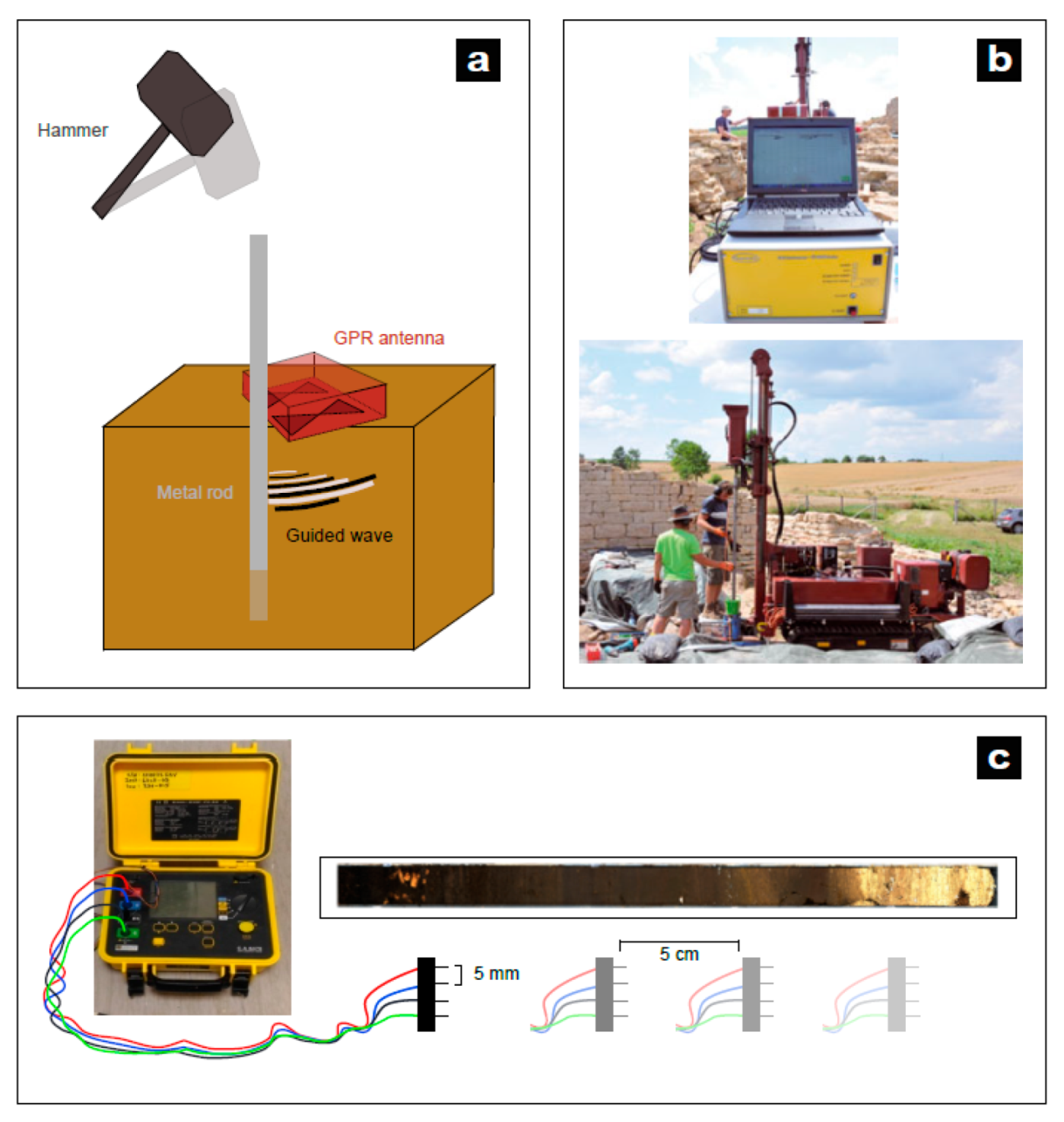
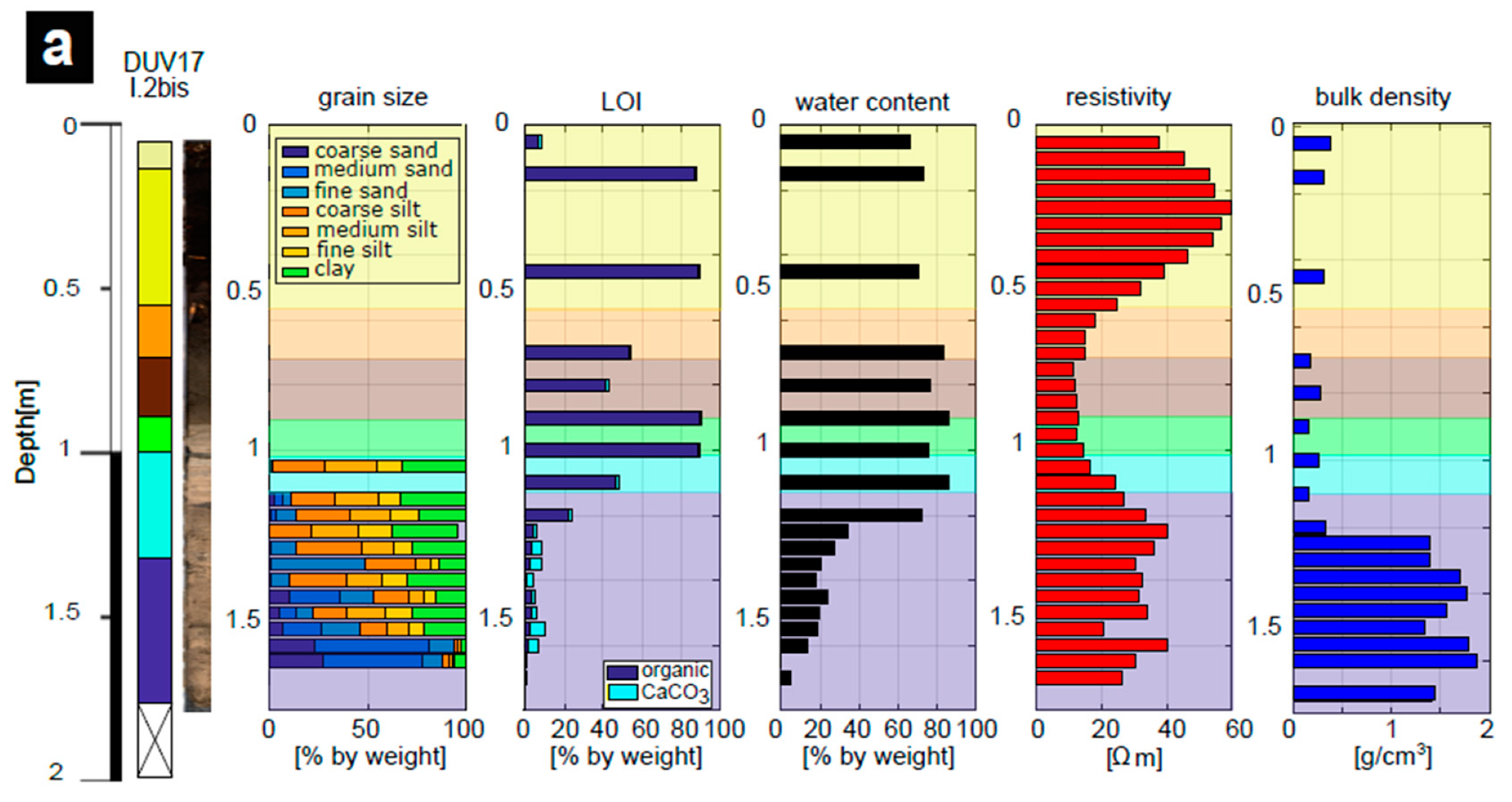

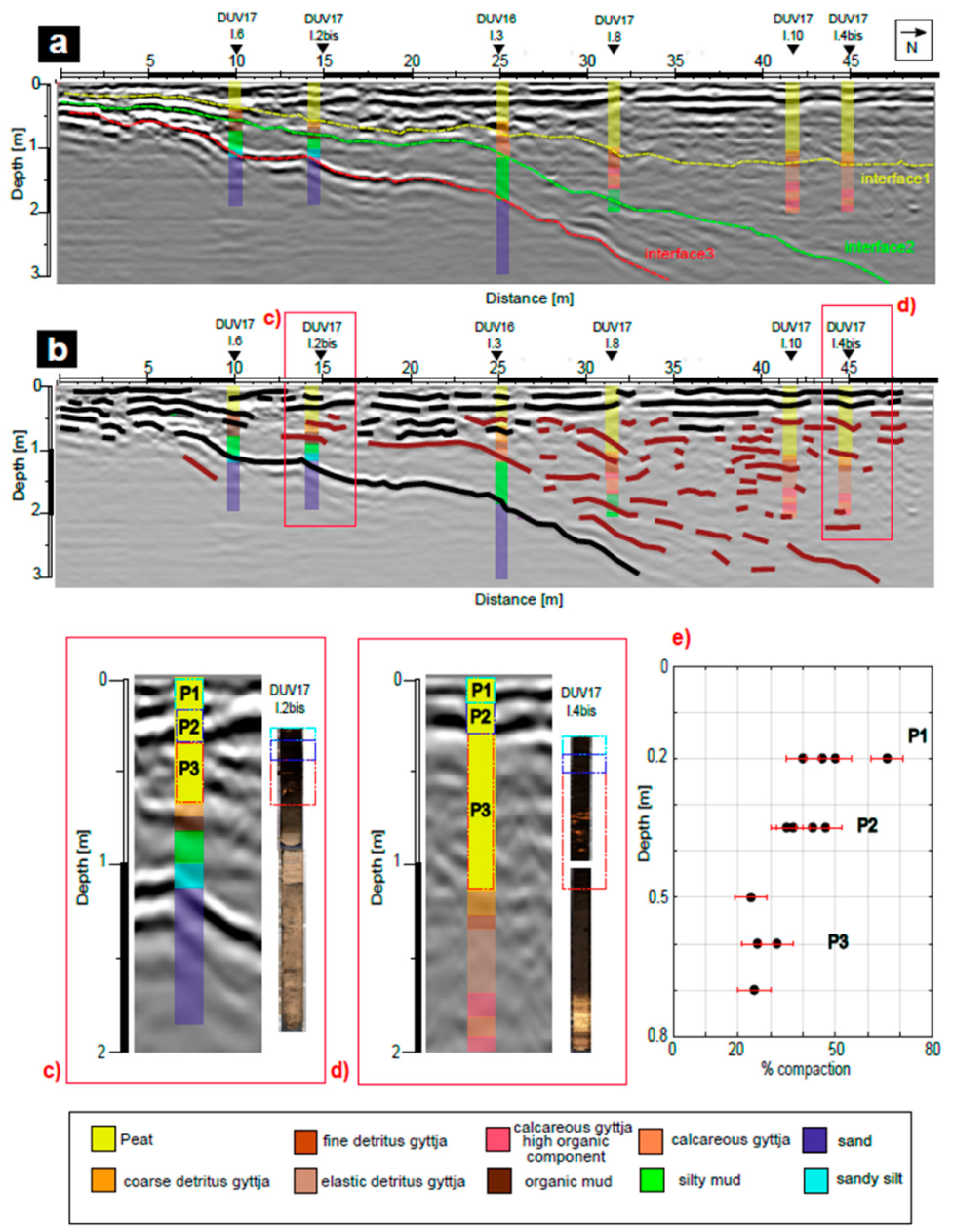
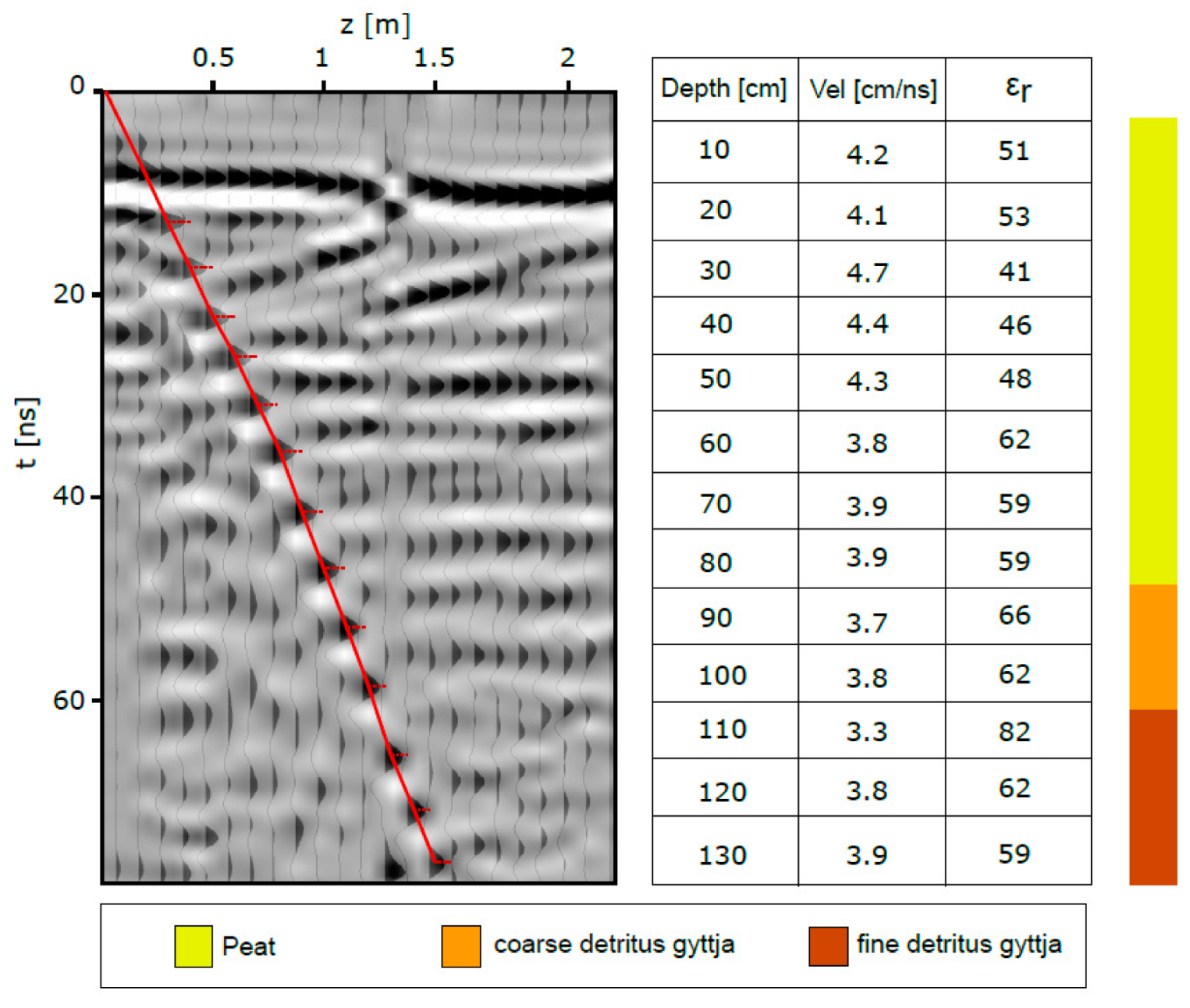
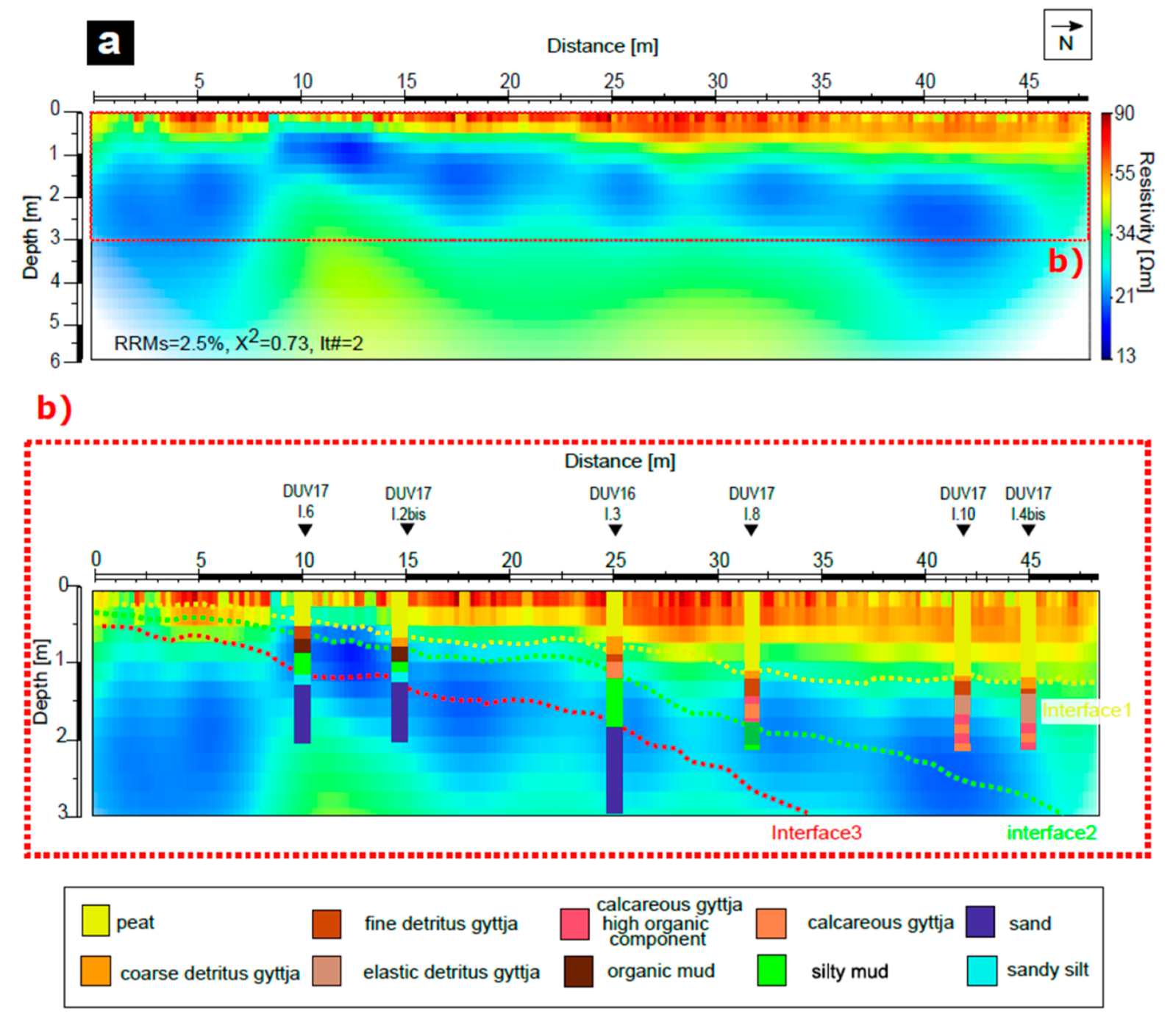
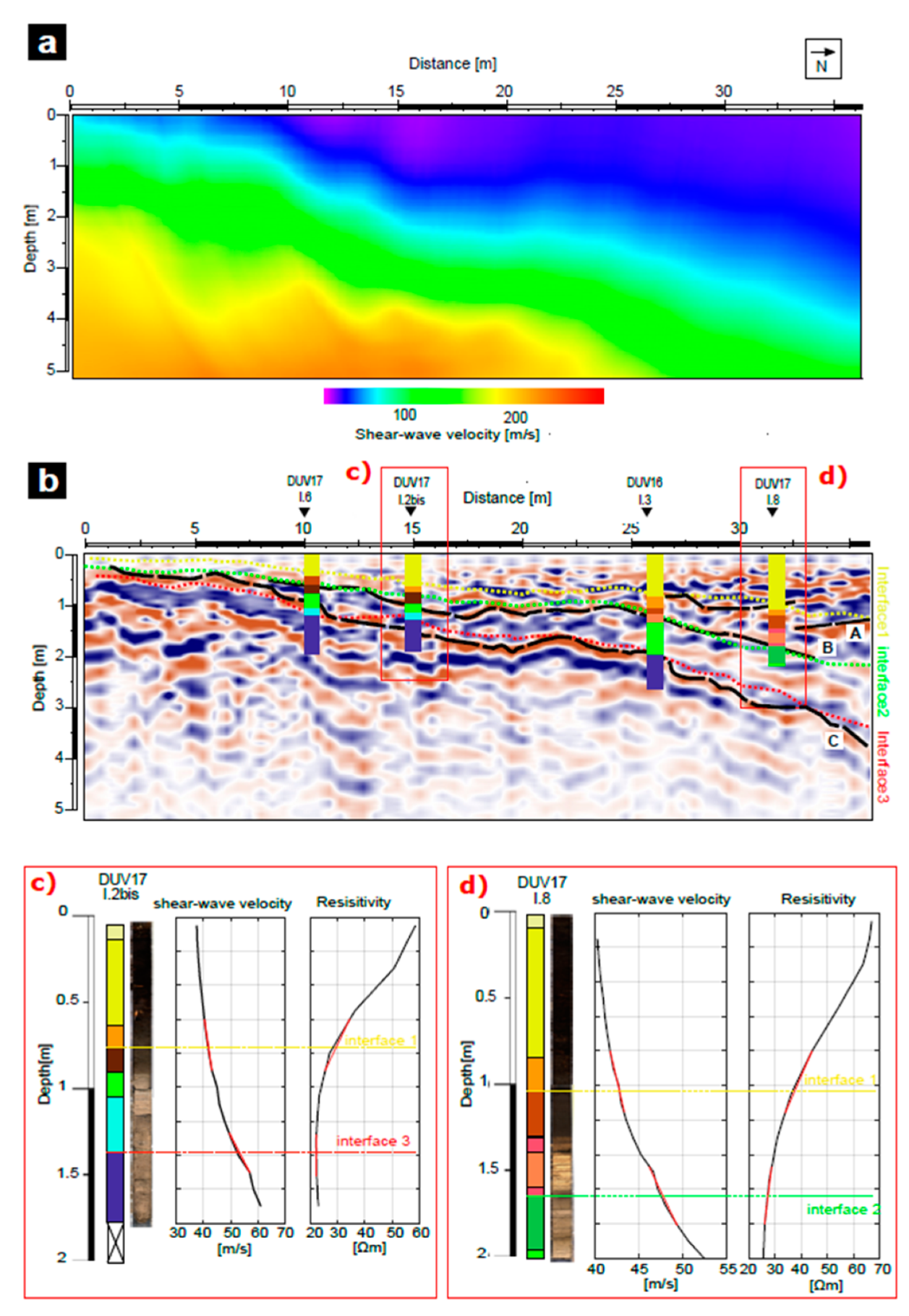

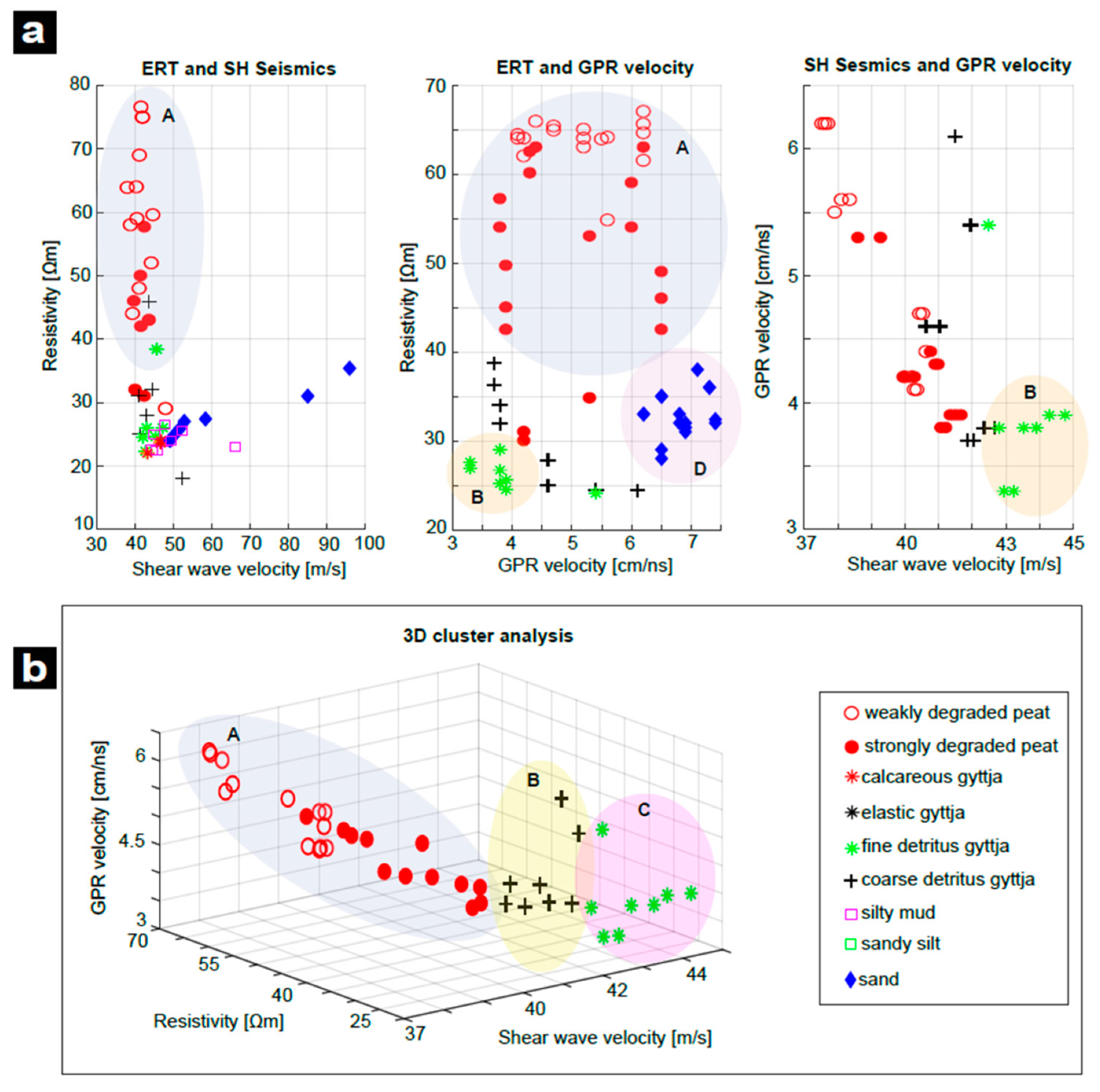
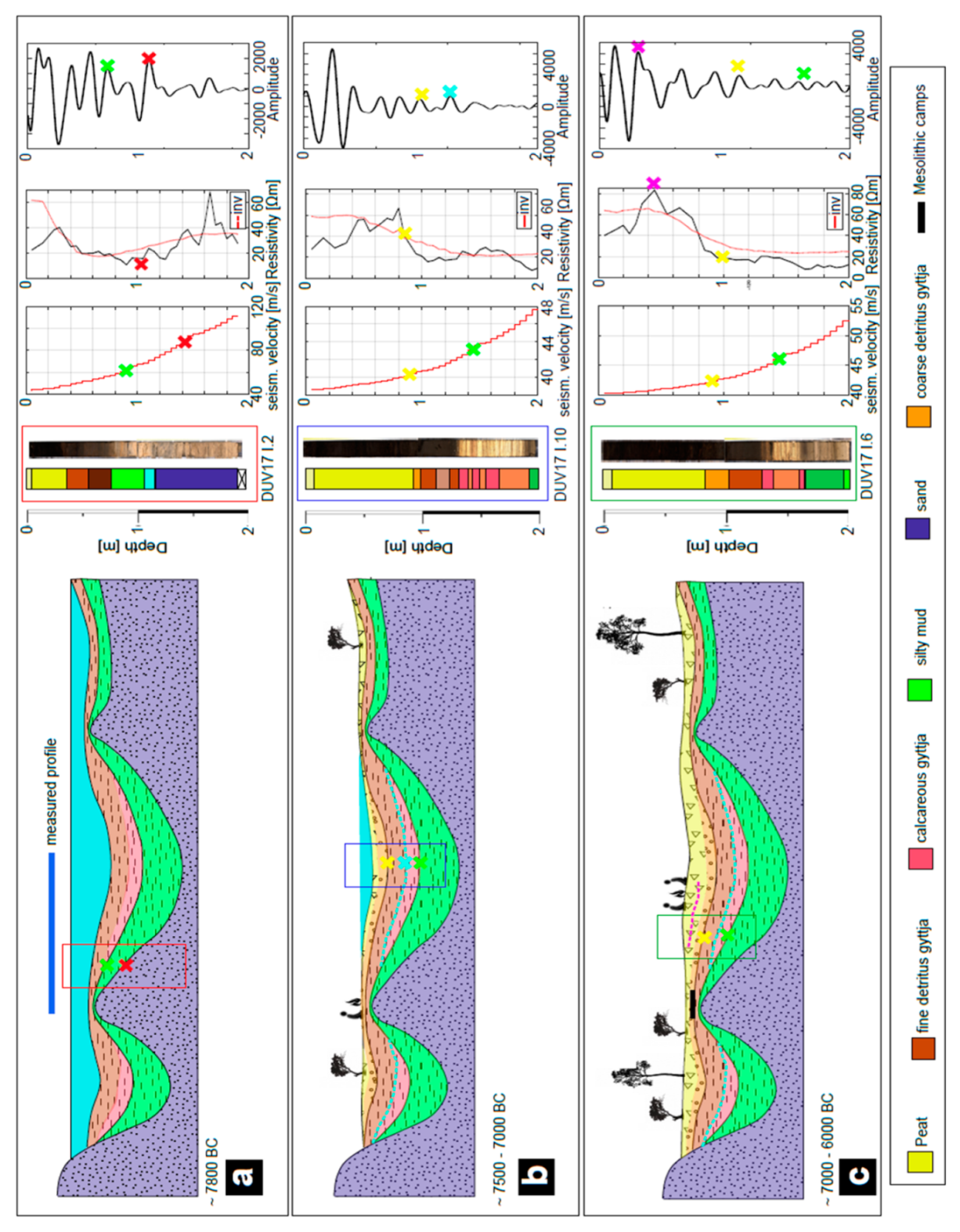
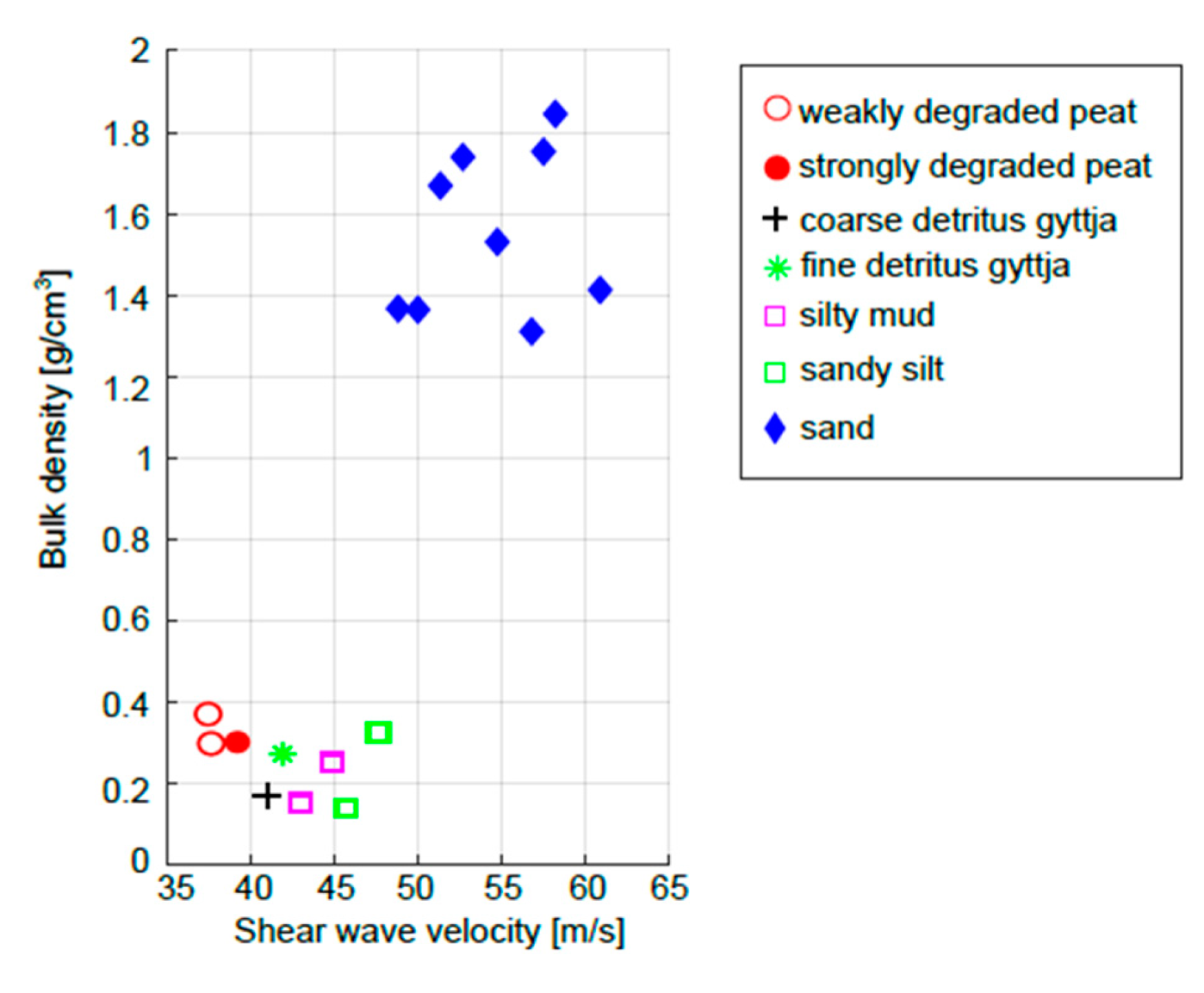
| Sediment | Water Content (%) | Organic Matter (%) | Resistivity [Ωm] | Conductivity [mS/m] | εr | SH Velocity [m/s] |
|---|---|---|---|---|---|---|
| weakly degraded peat | 66–84 | 89–95 | 37–70 | 27–14 | 41–53 | ~40 |
| strongly degraded peat | 70–86 | 87–97 | 24–40 | 42–25 | 59–62 | ~40 |
| Fine gyttja | 86 | 72 | 19 | 52 | 59–82 | ~80 |
| Coarse gyttja | 87 | 92 | 20 | 50 | 62–66 | ~80 |
| Calcareous gyttja | 42 | 17 | 22 | 44 | n.a. | ~80 |
© 2020 by the authors. Licensee MDPI, Basel, Switzerland. This article is an open access article distributed under the terms and conditions of the Creative Commons Attribution (CC BY) license (http://creativecommons.org/licenses/by/4.0/).
Share and Cite
Corradini, E.; Dreibrodt, S.; Erkul, E.; Groß, D.; Lübke, H.; Panning, D.; Pickartz, N.; Thorwart, M.; Vött, A.; Willershäuser, T.; et al. Understanding Wetlands Stratigraphy: Geophysics and Soil Parameters for Investigating Ancient Basin Development at Lake Duvensee. Geosciences 2020, 10, 314. https://doi.org/10.3390/geosciences10080314
Corradini E, Dreibrodt S, Erkul E, Groß D, Lübke H, Panning D, Pickartz N, Thorwart M, Vött A, Willershäuser T, et al. Understanding Wetlands Stratigraphy: Geophysics and Soil Parameters for Investigating Ancient Basin Development at Lake Duvensee. Geosciences. 2020; 10(8):314. https://doi.org/10.3390/geosciences10080314
Chicago/Turabian StyleCorradini, Erica, Stefan Dreibrodt, Ercan Erkul, Daniel Groß, Harald Lübke, Diana Panning, Natalie Pickartz, Martin Thorwart, Andreas Vött, Timo Willershäuser, and et al. 2020. "Understanding Wetlands Stratigraphy: Geophysics and Soil Parameters for Investigating Ancient Basin Development at Lake Duvensee" Geosciences 10, no. 8: 314. https://doi.org/10.3390/geosciences10080314
APA StyleCorradini, E., Dreibrodt, S., Erkul, E., Groß, D., Lübke, H., Panning, D., Pickartz, N., Thorwart, M., Vött, A., Willershäuser, T., Wilken, D., Wunderlich, T., Zanon, M., & Rabbel, W. (2020). Understanding Wetlands Stratigraphy: Geophysics and Soil Parameters for Investigating Ancient Basin Development at Lake Duvensee. Geosciences, 10(8), 314. https://doi.org/10.3390/geosciences10080314






